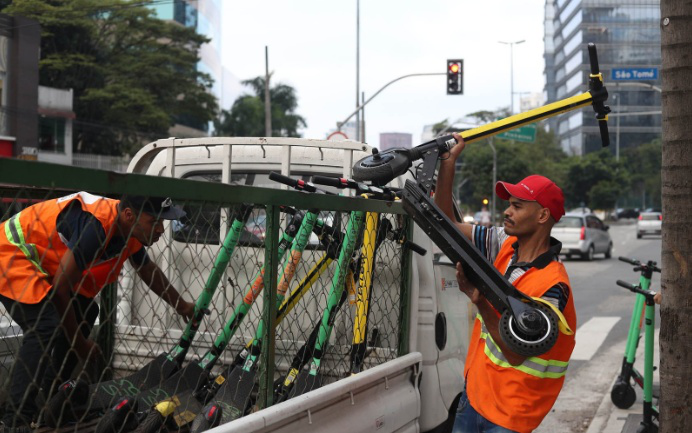Rapporteur of the Special Committee on Urban Mobility said he would include the topic in his report, which should be presented by the end of the year.
Should electric scooters only run on bicycle lanes or should they also be allowed on sidewalks or streets? Should the use of the helmet and reflective vest be mandatory? What is the maximum speed at which a scooter should travel? Where should they park? These were some of the issues discussed at a public hearing in the House of Representatives on Tuesday (4) about the regulation of the use of these vehicles.
The debate was promoted by the Travel and Transport committees; Science and Technology, Communication and Informatics; and the special commission on urban mobility (PL 4881/12). The mandatory use of the helmet was one of the topics that generated the most debate.
The representative of the National Traffic Department, Arnaldo Pazetti explained that Resolution (315/09) of the National Traffic Council already regulates the use of mopeds – with electric scooters such a species – but the rule may be updated by the agency. This resolution provides, for example, for maximum speed on sidewalks of 6 km per hour and 20 km / h for cycle paths; and don’t talk about wearing helmets for driving at these top speeds. “But nothing prevents the municipality from preventing the use of these vehicles on the sidewalk, for example. It is up to the municipality to regulate the matter,” he said.
Safety
The city of São Paulo, for example, issued a rule that prohibits the circulation of electric scooters on sidewalks and provides for the mandatory use of a helmet. However, a few days ago, the court released the use of scooters without safety equipment.
Caio Franco, Regulatory Director of Grow, believes safety equipment has to be encouraged, not mandatory. “In a huge part of the cases, this path is occasional and spontaneous. The citizen gets off the bus, sees a shared scooter and says ‘good solution.’ Instead of taking a car or riding a lot, I’m going to take this scooter and complete my last mile. And every Brazilian citizen having to carry a knee pad or a helmet in his suitcase would certainly make this solution, which has a lot of potentials,” he said.
According to Caio, electric scooter can help in the problem of urban mobility, highlighting that it is a small means of transport, which has less impact on traffic than other means. He added that limiting the circulation of electric scooters to bicycle lanes could be a problem, as not every city has them. He praised the solution adopted by the city of São Paulo to allow the circulation of scooters in “calm roads”, up to 40 km/h.
Shared Bikes representative Juliana Minorello, forcing companies to provide helmets is not the solution either. According to her, in Australia, this happened, and companies broke down. “If you make the company mandatory, you kill the model and end the modal, which has such a positive impact on the city,” he said. She noted that, in addition to having a positive impact on traffic, the use of shared bicycles and scooters reduces environmental and noise pollution, provides savings for users and helps improve the health of the population.
Traffic deaths
For the director of the Department of Health Analysis of the Ministry of Health, Eduardo Macário, the use of a helmet cannot be an individual choice; It should be a matter of public policy as it is essential to prevent injury. He further advocated limiting the speed of electric scooters and prohibiting the use of alcohol before driving any type of vehicle. He recalled that hospitalizations due to traffic accidents have a great impact on the Unified Health System (SUS).
José Luiz Nakama, from the São Paulo Municipal Secretariat of Mobility, believes that safety should be the main concern in regulating the matter. He stressed, however, that it is not enough to define maximum speeds of circulation since public agencies cannot supervise. “We have vehicles that can drive up to 40 km/h. If we do not require vehicles to leave the factory at full speed, we will have difficulty monitoring,” he said. According to him, it would be up to Contran to fix that limitation. He added that many accidents happen because users have no training. “If companies provided prior user training, accidents would be greatly reduced,” he said.
